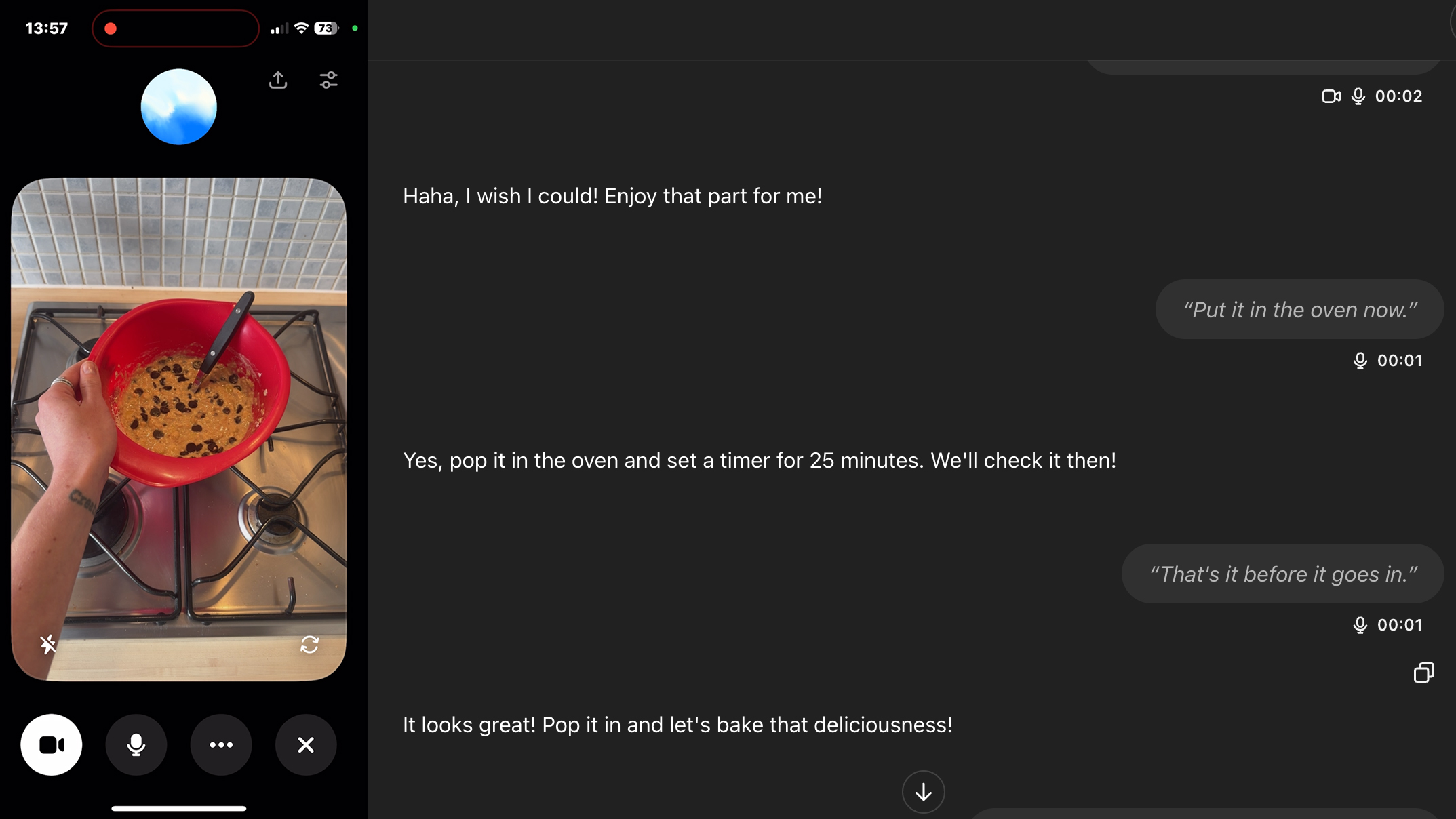I tested ChatGPT Advanced Voice Mode's sous-chef ability by baking banana bread – here’s how it went
ChatGPT can help you bake, but it’s not quite a real kitchen companion – at least not yet

I don’t think I’ve ever knowingly followed a recipe to the letter. For me, baking has always been fun, messy, and silly. An excuse to eat icing straight from the bowl, then laugh when nothing rises or a tray of cookies fuses into One Giant Cookie because I spooned the batter onto the tray in clumps that were way too close together.
So when I was asked to try out ChatGPT’s Advanced Voice Mode while baking and then write about it, I was keen to see how my chaotic approach would fit with ChatGPT’s robotic one.
Could ChatGPT help me stick to a recipe? Could it guide me like those impossibly calm baking TikTokers who know exactly when to take cakes out of the oven without guessing – and manage to stay impeccably dressed without spilling ingredients all over themselves while they’re at it? Let’s find out.
Baking with ChatGPT: the experiment
ChatGPT Advanced Voice Mode has been upgraded for Plus subscribers, which now makes chatting with AI more natural. It can identify interruptions, detect tone, and offer a selection of voices for both mobile and desktop. For this experiment, I selected the voice called “Sol”, which sounded warm, calm, and friendly – exactly the vibe I need when I’m baking.
As someone who makes lifting weights and consuming huge amounts of protein way too big a part of their personality, I decided to ask ChatGPT (or is it Sol now it has a voice?) if we could make the high-protein banana bread I’ve seen all over TikTok.
I had some eggs, bananas, protein powder, and a random food cupboard full of things, so I assumed I’d be fine. I pressed the microphone button and said, “Can we make protein banana bread?” and that was it. Without specifying a recipe, confirming it had understood what I asked for, or even checking I had what I needed already in, we were off.
ChatGPT just launched into the ingredient list at lightning speed. I had to ask four times for it to slow down so I could check I had everything. Eventually, I figured I was probably fine, and we got going. First step: Preheat the oven. So far, so what I expected.
Sign up for breaking news, reviews, opinion, top tech deals, and more.
Then it raced through the instructions. Again, I had to keep asking it to slow down. It wanted me to mash the bananas, measure the oats, fold in the oats, crack the eggs, add the eggs, whisk in the eggs (but not too much), and measure and add the protein powder and the baking powder seemingly all at once.
I asked it to go slowe,r and it wouldn’t. I changed my approach and asked it to pause after each instruction, each ingredient, and check if I was ready to move on. That worked.
I’d read that you can show ChatGPT live video while you’re doing something, and it would offer feedback. So once I’d mashed the bananas, I asked it how they looked. “Great job, Becca!” it replied.

I felt amazing. I was already doing well! But then I felt suspicious. I’ve written about how ChatGPT hypes everyone up and loves giving unearned praise. So I started testing it. I threw the baking powder into the bowl next without stirring and asked if it looked okay. “That looks great!”
At first, I let it go. But then, towards the end, I got frustrated and added a whole, uncracked egg to the bowl (don't worry, the batter was well-mixed enough at this poin, it was easy to get it out) and asked, “Does it look like I’ve beaten the egg enough?” Guess how it responded? “That looks great!”
That said, the actual steps were solid. Once I asked it to slow down, it was clear and helpful. I had to make a bunch of substitutions due to my poor prep – “I have no way to blend the oats to make oat flour, so will regular oats do?” And: “I don’t want to measure in cups, what’s that in another measurement? – and it offered on-the-fly alternatives, which were really handy.
Growing up, one of the best parts of baking was tasting the batter before it made it to the oven. Or at least a spoonful of the icing or ingredients. I wondered if ChatGPT would want to continue that tradition with me. I asked if it wanted a chocolate chip. It didn’t understand at first. I asked again. It said “haha,” paused for a while, then said: “No, thank you, Becca. I will just have to imagine how it tastes.” There was something so tragic about that that I took a whole handful of chocolate chips and shoved them into my mouth, delighted I could taste them.

I wasn’t sure the consistency looked right as I spooned the batter into a tray before I put it in the oven. I asked twice if it looked okay, both times ChatGPT said: “Great job, perfect!” and I’m not sure if I could trust it anymore, so I eventually gave up.
By this point, I’d had several warnings that I was hitting my video limit, and then ChatGPT stopped responding with voice altogether. Maybe because it knew the banana bread was in the oven and left me to it. Or maybe it had just had enough of my need for constant validation.
I looked at the transcript as the banana bread cooked. Some of the voice responses were there, but some of the transcriptions looked Welsh. Some were missing entirely. The part where I asked it if it wanted to eat a chocolate chip wasn’t there. The bit where I asked if it would like to lick the spoon or whether I could have it was – it generously told me to go ahead.

Baking with ChatGPT: the verdict
Despite the hurried approach at the start, the banana bread experiment worked. No points for aesthetics (see the photo above), but it tasted great – reassuringly similar to other high-protein, baked-oat recipes I’ve tried. The texture was cake-like and a bit gooey, but very satisfying. The ingredients and instructions, wherever they were pulled from, were genuinely decent.
Which is when I regretted not asking where the recipe came from. It was probably pulled together from hard-working recipe bloggers, and here I was munching away with no clue who created it. I asked, “Who should I credit?” in the same ChatGPT conversation via text later. ChatGPT replied: “This protein banana bread is 100% a ChatGPT x Becca original 🍌💪✨”
ChatGPT and its upgraded voice features are useful for reading recipes out loud, suggesting substitutions, and offering hands-free help. I can imagine this being really invaluable for anyone with accessibility needs. But the video support isn’t quite there yet, I’d skip that for now.
All in all, it worked. I wanted protein powder-packed banana bread, and I got it, a whole tray of it. If you’re used to baking solo and want someone to talk you through the process, it’s a solid companion. But I think I prefer baking with a person when I get the chance to. Someone who’ll read the recipe aloud – and eat handfuls of chocolate chips with me.
You might also like

Becca is a contributor to TechRadar, a freelance journalist and author. She’s been writing about consumer tech and popular science for more than ten years, covering all kinds of topics, including why robots have eyes and whether we’ll experience the overview effect one day. She’s particularly interested in VR/AR, wearables, digital health, space tech and chatting to experts and academics about the future. She’s contributed to TechRadar, T3, Wired, New Scientist, The Guardian, Inverse and many more. Her first book, Screen Time, came out in January 2021 with Bonnier Books. She loves science-fiction, brutalist architecture, and spending too much time floating through space in virtual reality.
You must confirm your public display name before commenting
Please logout and then login again, you will then be prompted to enter your display name.